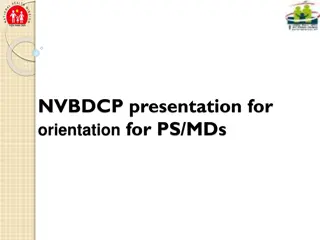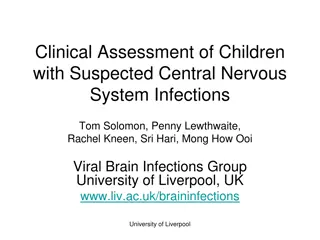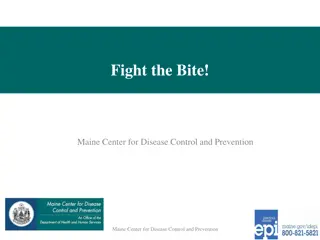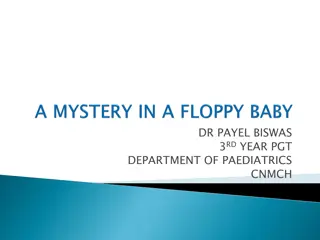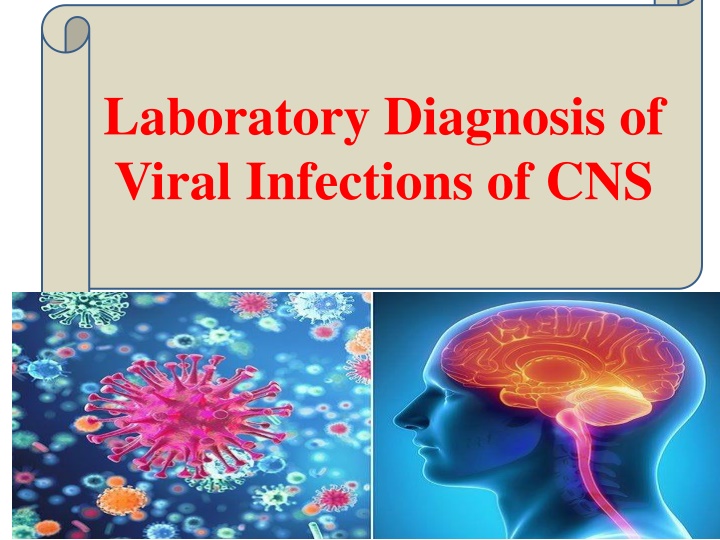
Laboratory Diagnosis of Viral Infections of CNS: Techniques & Causes
Explore the laboratory diagnosis of viral infections affecting the central nervous system (CNS), including techniques for identifying viral pathogens. Learn about causes of viral meningitis and encephalitis, as well as the diagnostic procedures used to detect viral diseases, such as CSF examination and serologic detection of antibodies.
Download Presentation

Please find below an Image/Link to download the presentation.
The content on the website is provided AS IS for your information and personal use only. It may not be sold, licensed, or shared on other websites without obtaining consent from the author. If you encounter any issues during the download, it is possible that the publisher has removed the file from their server.
You are allowed to download the files provided on this website for personal or commercial use, subject to the condition that they are used lawfully. All files are the property of their respective owners.
The content on the website is provided AS IS for your information and personal use only. It may not be sold, licensed, or shared on other websites without obtaining consent from the author.
E N D
Presentation Transcript
Laboratory Diagnosis of Viral Infections of CNS
Intended learning objectives Understanding microscopic features and laboratory techniques for diagnosis of causative viral pathogens.
Meningitis Causes of viral meningitis (aseptic meningitis): Enteroviruses i.e. coxsackie virus, echo virus, poliovirus and mumps virus are the main viral causes. Arboviruses, herpesviruses, rubella, CMV, rabies and many other viral agents can cause meningitis and encephalitis.
Encephalitis Causes of viral Encephalitis: The most common identifiable cause of viral encephalitis is from Herpes simplex infection. Other causes of acute viral encephalitis are rabies virus, poliovirus and measles virus. Additional possible viral causes are: Arboviruses flavivirus (St. Louis encephalitis, West Nile virus),Sindbis virus, Bunyavirus (La Cross strain), Arenavirus (lymphocytic choriomeningitis virus), reovirus.
DIAGNOSIS OF VIRAL INFECTIONS The laboratory procedures used in diagnosis of viral diseases include: I. Direct methods by: A -Detection of viruses in clinical specimens. B -Detection of viral components in clinical specimens: 1-viral proteins. 2-viral nucleic acid. C -Detection of cytopathic effects in the cells of clinical specimens. D -Isolation of viruses. II. Indirect methods by: Serologic detection of antiviral antibodies.
CSF examination in case of viral meningitis ** CSF is obtained by lumbar puncture under complete aseptic conditions in 2-3 sterile tubes. It should be immediately examined as follows: Physical examination: In aseptic viral meningitis it is clear or slightly turbid due to small numbers of lymphocytes. Chemical examination: for the level of proteins and glucose. In viral meningitis, proteins are slightly increased while the glucose is normal. Cytological examination: Normal cell count in CSF is 0-5/cmm. In viral meningitis the number of cells does not exceed 1000/cmm and are mainly lymphocytes.
HERPES SIMPLEX VIRUSES HSV multiplies locally in the mucous membrane or abraded skin causing cytolysis, necrosis, ballooning, multinucleated giant cell formation and intranuclear inclusion bodies in infected cells. Cell fusion provides cell-to-cell spread of HSV, even in the presence of neutralizing antibodies. Diagnosis: 1- Tzanck smear; in which scrapings from the base of skin lesions are stained with Giemsa. The presence of MULTINUCLEATED GIANT CELLS suggests HSV infection. 2- Detection of viral antigens or viral DNA in vesicular fluid by immuno-fluorescence or by DNA probes or PCR. 3- A rapid diagnosis of encephalitis can be made by detecting HSV DNA in CSF by PCR.
5- Serologic diagnosis by detection of a rise in antibody titre may be useful in primary infection. Detection of IgM antibodies in the newborn sera indicates intra- uterine infection. 4- Isolation of the virus from herpetic lesions. Cytopathic effect occurs in 1-3 days. Virus is identified by immunofluorescence or ELISA. Tzanck smear stained by Geimsa stain showing Multinucleated giant cells
RABIES VIRUS The virus is a rhabdovirus 75x180 nm It is a bullet shaped enveloped, single stranded (negative sense) RNA virus and contains an RNA polymerase. The virus is transmitted to man from the bite of a rabid animal. Diagnosis Antemortum diagnosis in humans: Specimens include full-thickness skin biopsy from the nape of the neck including hair follicles, corneal impression smears (taken by an ophthalmologist), saliva, CSF and serum. These are examined as follows: 1-Antigen detection by immunofluorescence in skin biopsy and corneal smears. 2-Virus isolation from saliva and CSF using continuous cell culture, or by intracerebral inoculation of mice. 3-RT-PCR applied to the above specimens except the serum 4-Antibodies appear 2 weeks after illness in serum and CSF and are tested for by ELISA, neutralization or immunofluorescence.
Diagnosis in animals: Immediately after the bite, the animal should be captured and observed for 10 days. If no symptoms appear during this period the diagnosis of rabies is excluded. If the animal dies or symptoms appear the animal is sacrificed, and diagnosis is done as follows: 1- Antigen detection by direct immunofluorescence in brain smears. 2- Detection of "Negri bodies" in stained brain smears. 3- Isolation of the virus from brain or sahva as above mentioned. 4- RT-PCR applied to brain tissues.
Intracytoplasmic negri bodies by light microscope
Cytomegalovirus CMV is one of herpesviruses , CMV infected cells are massively enlarged and hence the name. It is transmitted transplacentally, within birth canal, breast milk, saliva, sexually, blood transfusion, organ transplants. Diagnosis: 1- detection of intranuclear cytomegalic inclusions which are oval owl,s eye shape in tissuesor desquamated cells in urine 2- detection of CMV nucleic acid in tissues and body fluids, blood, CSF, amniotic fluid by PCR. 3- isolation of virus from throat washing and urine. Detection of IgM or rising titre of IgG is diagnostic.
intranuclear cytomegalic inclusions which are oval owl,s eye shape in tissues or desquamated cells in urine
intranuclear cytomegalic inclusions which are oval owl,s eye shape in tissues or desquamated cells in urine
Case study1: A 45-year old male, whose occupation was building worker, presented to the emergency department with generalized spasm and rigidity of body and difficulty in opening of mouth since 2 days. On examination, the medial aspect of the right forearm revealed an infected wound. When questioned about the wound, the patient stated he had received it at work 10 days ago and he had received topical medication. When asked about immunization status, the patient denied receiving prophylaxis for the wound and stated that as far as he could remember he had never received any childhood or adult vaccinations. What is the suspected clinical diagnosis and how to confirm your diagnosis? What is the treatment should be given to this case? What is the virulence factor responsible for this disease and mention its mechanism of action? How to prevent this disease?
Case study 2 A 4 year old girl developed drowsiness, abdominal pain, anorexia, drooling, and pain on the left side of the neck for 2 days. The following day, she developed fever and behavioral changes. She had hallucinations, difficulty standing, insomnia, and refused to drink liquids.. She then developed a seizure and bradycardia, requiring cardiopulmonary resuscitation. She was transferred to an ICU .Nine days after the onset of symptoms, she died. During the hospitalization, family members reported that approximately three weeks prior to the onset of symptoms, a bat had been found in the child's bedroom. The child's autopsy showed Intracytoplasmic inclusions were present in the brain. Questions 1. Is strict isolation necessary for this patient? What was done for exposed contacts? 2. What is the incubation period for rabies? 3. What clinical symptom did this patient have which is classic for rabies? 4. If the family had reported finding the bat in the patient's room immediately to the physician or health department, what treatment would the patient have received? 5. Who should routinely receive rabies virus vaccine?












